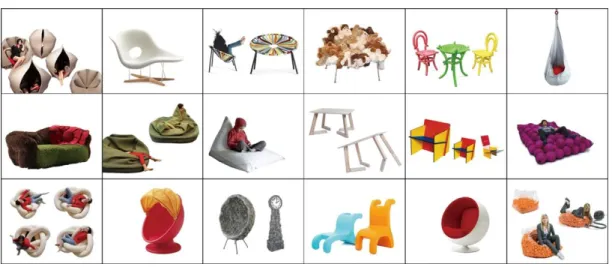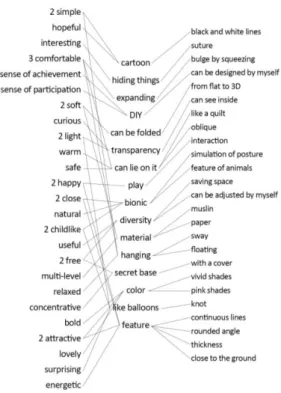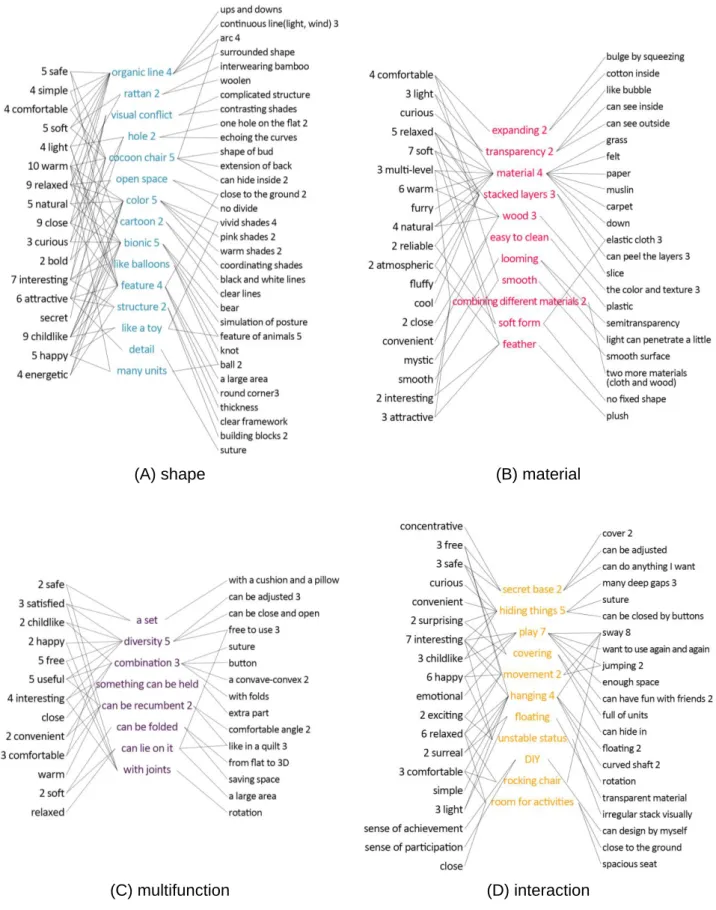KEER2014, LINKÖ PING | JUNE 11-13 2014
INTERNATIONAL CONFERENCE ON KANSEI ENGINEERING AND EMOTION RESEARCH
A study of the attractive factors for the kidult furniture
Yi-Ning Lee 1, Chun-Heng Ho 2 1
National Cheng Kung University, Taiwan, yininglee1990@hotmail.com
2
National Cheng Kung University, Taiwan, hoch@mail.ncku.edu.tw
Abstract: With the changing times, people not only concern about the functions of a product but
also focus on the emotional connection with a product. Taking furniture, for example, it is a part of our life because we use and rely on it every day. When people interact with it, an emotional connection is then built up. As a result, it is particularly important that new furniture design can satisfy the emerging needs in emotion. In this study, the authors would catch the idea of "kidult", which combines the two words ‘kid’ and ‘adult’. It means a person who continues to participate in and enjoy youth culture (McFedries, 2002). Nowadays, the "kidult furniture" already exists in the market, whereas the definition and the features of this kind of furniture are not clear. Therefore, in this study, the authors used “Evaluation Grid Method” to explore the attractive factors of kidult furniture. Then the factors were justified by the discussion of the existing design projects. As a result, this study proposed some important abstract and concrete features for kidult furniture which can be categorized into four categories, i.e. shape, material, multifunction, and interaction. In the future, this finding would help designers to design kidult furniture better.
Keywords: Emotion, Furniture, Kidult, Evaluation Grid Method, Miryoku Engineering.
1. INTRODUCTION
of consumption has developed from "subsistence" to "culture", so people would put more emphasis on the extra emotion of the products rather than only on the function of the products.
During the process of human civilization, people create a lot of vocabulary to describe different kinds of group, such as Bobo, Kidults, freeters, metrosexual and so on, and each of the group has its own habit or special ideas. In this study, the authors choose one of the groups, kidult, to have more discussion, in spite of that there is few literature about this. In terms of the kidult group, the authors believe that everyone has childlike innocence to some extent. Therefore, the authors want to explore everyone's thinking of kidult furniture. One feature of childlike innocent people is that they want to be themselves. Just like children who do not need to think too much. This idea also corresponds to that kidult people want to use furniture freely. Therefore, it is possible to add this idea to the furniture design. With doing this, the user might feel freer and closer when they use kidult furniture. Although this kind of furniture has already existed in the market, it is lack of clear definition. So the purpose of this research is to explore this field more and give it an appropriate definition.
Consequently, this study discusses the background of kidult and its influence on design first. Following that, the authors use the perspective of emotional design to analyze the elements of kidult furniture. Subsequently, the authors use "Evaluation Grid Method" to catch the attractive factors of kidult furniture.
2. BACKGROUND
2.1. The origin of kidult
The term "Kidult", which combines the two words ‘kid’ and ‘adult’, was firstly proposed by Peter Martin in 1985 in the New York Times. It is defined as a middle-aged person who continues to participate in and enjoy youth culture (McFedries, 2002). People who have this perspective seem to have mature adult appearances, but actually possess a child's mind and behavior. Initially, kidult is just an external feature, but it gradually becomes an inner spirit (Pan, 2004).
2.2. Evaluation Grid Method (EGM)
In Miryoku Engineering, Evaluation Grid Method (EGM) is one of the important research methods. It originated from the category of psychology, was adapted from Repertory Grid Method (RGM), and was created by Sanui in 1997, who was a Japanese scholar. The RGM was proposed by Kelly (1955). Kelly caught the idea of personal cognition and arranged it into grid chart. Through the personal interview, discussing the difference and the resemblance of two objects with the participants to get the consecutively sorted personality (Kelly 1955). In this study, by using ”Evaluation Grid Method”, the authors need to interview a group of people who are interested in kidult furniture. Then, the focus group will come up with the original concepts of kidult furniture. Based on the original evaluation item, the participants will be asked to try to link the ladder-up evaluation item and the ladder-down evaluation item to their original evaluation item. Finally, the authors will integrate the information and make a network of attractive factors.
3. METHODOLOGY
In this research, the authors interview with participations according to the Evaluation Grid Method first, and then the authors collate the data and analyze them to extract the attractive factors of kidult furniture.
3.1. Preparation for interview
out the remained ones, and finding the suitable participations. 3.1.1. Collection and filter of pictures
First, the authors need to collect the clear pictures of kidult furniture extensively, and the total number of collection is 100. Second, in order to make sure that all the pictures meet the standard of the research, the authors find an expert designer of kidult furniture to filter some of them, and the standards of filter are that if this furniture does not belong to kidult furniture, if it is just a concept, and if there is a similar one in the pictures. Finally, there are 52 pictures remained.
3.1.2. The process of making out the cards
In order to let the participations can see and compare the cards more easily in the interview, the authors need to remove the background of the pictures to remain the furniture itself, for example figure 1.
Figure 1: Remaining the furniture itself
After removing the background of the pictures, the authors make each pictures to become 12cm x 10cm cards, for example figure 2.
Figure 2: Part of the cards for interview 3.1.3. Participants and tools
In the research, the author invites three male and tree female participants, who studied industrial design for more than four years, and had the relative work experience. Despite of that, all of them are financially independent. The form of the interview is one-to-one, and each person has about one hour. As for the tools, which may be needed in this research, are the cards of kidult furniture, log sheets, pens, and a camera.
3.2. Interviews
The process of interviews
1. Invite the participants to have interviews.
2. Let the participants separate the 52 cards to two groups, one of the group they like and the other one they do not like, for example figure 3.
3. Let the participants group the cards which they like again, according to the different reasons they like, for example figure 3.
Figure 3: Grouping cards
4. Let the participants explain the reasons for the grouping to make the original evaluation items (original reasons), for example: cocoon chair, bionic, and so on.
5. According to the original evaluation items (original reasons) the participants said, the authors would ask more about the abstract feelings (ladder up) and concrete conditions (ladder down) as shown in figure 4.
Figure 4: The example of asking ladder-up and ladder-down evaluation item 6. Make out the Evaluation Grid Chart.
4. RESULT OF THE EVALUATION GRID CHART
4.1. Catch of the attractive factor
Figure 5: Participation A's Evaluation Grid Chart
4.2. Category of the attractive factor
After collating all of the original evaluation items (original reasons), the authors separate them to four categories, which are "shape", "material", "multifunction", and "interaction", and mark them with different colors, which are blue, pink, purple, and yellow respectively; the participant A’s classified Evaluation Grid Chart is shown in figure 6.
Figure 6: Participant A's classified Evaluation Grid Chart
Evaluation Grid Chart of four categories to make the later analysis easier, e.g. figure 7.
(A) shape (B) material
(C) multifunction (D) interaction
4.2.1. Extraction - abstract feelings
In order to make the result of this research more representative, the authors would extract the most frequently mentioned abstract feelings to have more discussion. In the Evaluation Grid Charts, the first chart is "shape", and its top 5 mentioned feelings are "warm", "childlike", "relaxed", "close", and "interesting"; in the second chart - material, its top 5 mentioned feelings are "soft", "warm", "relaxed", "comfortable", and "natural"; in the third chart - multifunction, its top 5 mentioned feelings are "useful", "free", "interesting", "satisfied", and "comfortable", and in the last chart - interaction, the "interesting", "happy", and "relaxed" are the top 3 mentioned feelings.
4.2.2. Extraction - original reasons and solid items
According to the top 5 or top 3 mentioned abstract feelings of each category, in this section, the authors find their corresponding original evaluation items (original reasons) and the solid items. In addition, the authors also count how many times each of the items were mentioned and make out four tables.
5. DISCUSSION
The purpose of this study is using the Evaluation Grid Method to extract the attractive factors of kidult furniture, and the authors hope that in the future, the attractive factors can be referred by someone who would like to design kidult furniture. According to the analysis, the authors have some suggestions about this field.
1. Shape: The authors find that the shape which has the feature of a cocoon chair, with organic lines or having some features of animals can let the users feel more relaxed and warmer when they use this kind of furniture. As for the color, both of the vivid shades and pink shades can be accepted. In addition, if the designer can add some details on the furniture, such as the round corner, the furniture can be more attractive.
2. Material: According to the analysis, people prefer to the elastic cloth, natural material, or soft, furry texture, such as grass, felt, and down. When people use this kind of material, they would feel comfortable and relaxed.
3. Multifunction: Based on the result of the research, people prefer the changeable kidult furniture, where they can adjust the form by themselves. The furniture does not need to have a fixed shape; its shape can be assembled into different forms. With these features, users would feel freer, more interested and satisfied.
4. Interaction: The authors find that if the designer can add some features of interaction to the furniture, such as that people can hide things inside, the furniture can be swayed, or it has enough space which can let people play with their friends. This kind of kidult furniture would let people feel more interested and happier.
5.1. Shape :
Figure 8: The matched sample of shape
This category of kidult furniture has the feature of a cocoon chair; its shape can be imagined to be similar to a hug, which is like curling in a mother's arms. This image would also affect people's feelings and make them feel warm and attached to the furniture. Furthermore, the warm shades would also make these feelings stronger and provide comfort and safety for the users. As for the details, this kind of furniture also uses the short sutures, thick cushion, short and rounded legs or even on the ground directly. These details would make people think they are lovely and they can feel closer to the furniture.
5.2. Material :
Figure 9: The matched sample of material
In this category, the materials are softer, such as feather, muslin, and elastic cloth, and people would be attracted by these. For instance, the large area which is made of plush or stacked layers would make people want to go through it and roll on it to feel its softness, which is just like a child's behavior, and they would get comfortable and childlike feelings. The furniture which is made of cotton and elastic cloth would make people want to lie on it directly.
5.3. Multifunction :
Figure 10: The matched sample of multifunction
5.4. Interaction :
Figure 11: The matched sample of interaction
This category of kidult furniture can particularly have interaction with users, for instance, hiding things in the special gap of the furniture. The furniture is like people's friend and it can help people keep things, so people can easily have the emotion with this kind of furniture when they use that. As for the hanging or rocking chair, most of the users would drive it to make it sway. This feeling can be connected to the childhood, such as we were held and swayed by the adults or sitting on the toy horse and riding it. These happy feelings and interesting experience can let people feel like a child when they use these kind of furniture.
6. CONCLUSION
In this study, the authors had already classified the features of kidult furniture to four categories, which are shape, material, multifunction, and interaction. When people use this kind of furniture, the furniture could inspire them to have stronger feelings, such as safe, warm, relaxed, free, interesting and so on, which are also the reasons why people like kidult furniture.
Consequently, people prefer to the kidult furniture which can use with more freedom or can make a good connection with the happy memory or an interesting experience in their childhood. In this study, the authors focus on the emotion of kidult and have more discussion on how those emotions connect with the kidult furniture. The authors hope that this kind of research can be further
expanded in the future, including having more research on the kidult products and analyze whether there exist other important attractive factors. Thus, designers would know how to apply this emotion to different types of products better in the future.
REFERENCES
Kelly, G. A. (1955). The psychology of personal constructs. Vol. 2, New York: Norton.
Ma, Y. C. (2011). A study of the Fitness Equipment Attractive Factor From the Feminine Product Involvement (Master's dissertation, National Cheng Kung University, 2011).Tainan, Taiwan.
McFedries, P. (2002, September 16, 2002). Kidult. Retrieved 5/1, 2014, from
http://wordspy.com/words/kidult.asp
Miryoku Engineering Forum. (1992). Miryoku Engineering. Kaibundo Japan. Pan, K. L. (2004, June). Kidult. City Pictorial.





